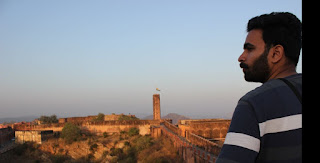Adaptive Reuse in Rajasthan by Harman Singh (with edits by Shriya Gautam)
“The study of the past is the main portal through which culture is acquired.”
― Joseph Epstein
 |
| Harman Singh is a CArch+Workshop Member at Speaking Archaeologically |
Rajasthan is considered an important tourist destination in India because of its rich cultural heritage and diverse scenic beauty. An amalgamation of the desert of Thar and the hills of the Aravalli Range, Rajasthan is notable for its floral and faunal variety. To add to this, the variety in handicrafts, music, dance and sheer vividity of attire is a true treat for a traveller.
Last year, I got a chance to visit the Rajasthani cities of Jaipur, Ajmer and Udaipur. The whole state is of extreme significance to the history of India, a fact illustrated by its fortified cities and magnificient palaces, its breath-taking temples and serene Sufi shrines.
Interestingly, the concept of Adaptive reuse is perhaps put to maximum use in the monuments of Rajasthan than any other place in India, perhaps. Many old Havelis, forts and palaces from Ancient and Medieval times have been converted into hotels, motels and B&Bs. Big entrepreneurs, like Tata & Oberoi, have invested large capital in these ventures, which include but are not limited to, using them as hotels, museums and restaurants, to enhance the tourism industry. The city palaces of Jaipur and Udaipur, which are inherited properties of Rajputs, thus, serve more than a tourist attraction otherwise might. They not only solve the purpose of dissemination of knowledge about the life of the Rajput families who lived there (as historical monuments do) but are also used for destination weddings, parties and other events among others.
However, Adaptive Reuse does not necessarily protect the historical monuments from the ravages of modern times. The threats to heritage stand regardless and stand taller, if at all. The most perturbing from among these is urbanisation. Urbanisation, is of special concern to those of us who understand the great value of cultural heritage sites. Close agglomeration of buildings, houses and markets pose an imminent danger to these sites. To add up to the problem, pollution in the vicinity, urban congestion and also, remodeling and restructuring of these buildings is no help.
Restructuring of the buildings, with scant regard for the materials of make employed in the original structure, can result in life-threatening hazards. Also, since the original purpose of most of the adapted buildings is in stark contrast to how they are being used now, most buildings are ill suited to the uses they are now employed in.
Another concern, especially in case of lesser known but now adapted heritage monuments, is that prior to remodeling and renovation, the original features were neither studied nor recorded and scant regard was paid towards recording their history. This has resulted in irretrievable loss of historical knowledge and information, just like the proverbial fallen tree in the unexplored forest.
Thus, adaptive reuse can become controversial as there is sometimes a blurred line between renovation, facadism and adaptive reuse. It can be regarded as a compromise between historic preservation and demolition.
Unfortunately, the threats of adaptive reuse are not just limited to the commercial reuse itself. Tourism, too, frequently causes natural harm like contamination, vandalism and damage to antique property. While the Government of India has launched a policy on Sustainable Tourism Criteria to emphasise on different areas of tourism, a defeinitive Cultural Heritage Law, especially one that caters to Adaptive Reuse of Old Heritage sites is the need of the hour. India is losing thousands of sites almost every month to rampant urbanisation and infrastructural development among other human activities. Loopholes in history and culture are glaring more and more fiercely every day. Thus, Sustainable Adaptive Reuse and extension of Corporate Social Responsibility to the Adapted monuments is much needed.



Comments
Post a Comment